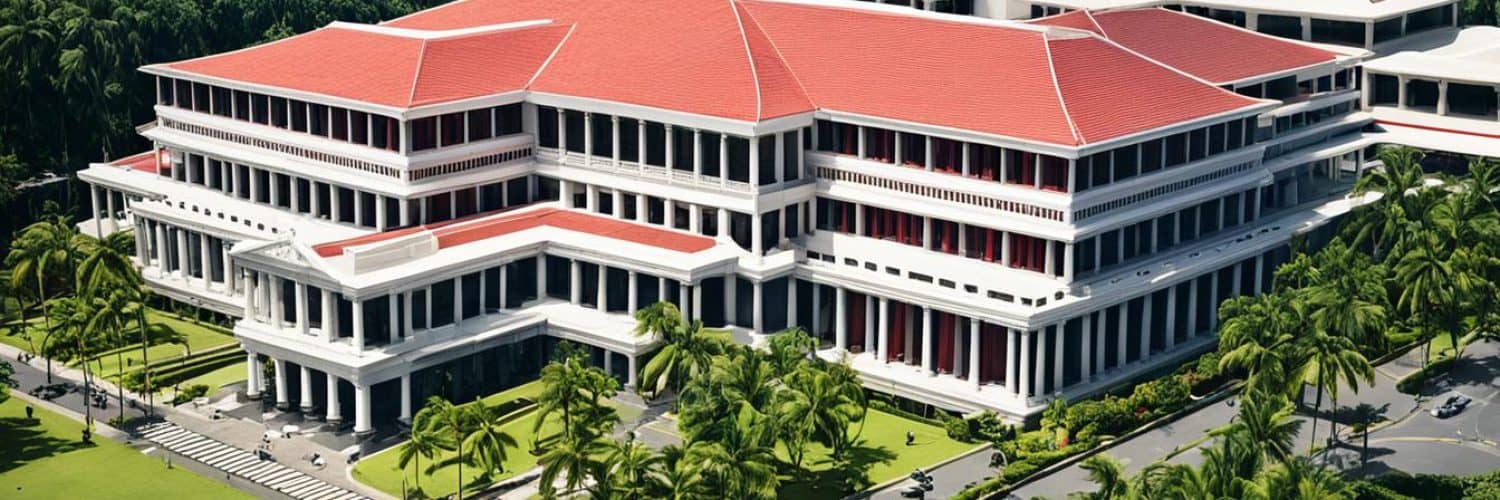Have you ever wondered what untold stories lie buried within the historical archives of the National Archives of the Philippines? From rare manuscripts to personal diaries, this vast collection of historical documents offers a fascinating glimpse into the rich tapestry of Filipino history. But how are these valuable records preserved and made accessible to the public? Let’s unravel the secrets hidden within the walls of the National Archives and discover the hidden gems of our nation’s heritage.
Key Takeaways:
- The National Archives of the Philippines houses a vast collection of historical documents.
- These records provide insights into Filipino history, including the Pacific War during World War II.
- The preservation and accessibility of these records are essential to ensure their longevity.
- Researchers can explore various resources, such as libraries and online catalogs, to delve into Filipino history.
- The National Archives Catalog provides a comprehensive listing of records available for research.
Origins of the Collection
The Philippine Archives Collection originated from various organizations operating in the Philippines during World War II. These organizations played a crucial role in documenting the events and experiences that unfolded during the Pacific war. After the war, the records were collected by the War Department from different locations including the Philippines, Japan, and Korea.
These significant records were then brought to the National Archives and Records Administration in Washington, DC, where they were curated and preserved for future generations. The collection primarily focuses on the individual experiences of men and women who served during the Southwest Pacific Area control, both in military and civilian capacities.
The records within the collection offer valuable insights into the activities, conditions, and experiences of individuals during this tumultuous period. Through personal accounts, diaries, and other documents, researchers can gain a deeper understanding of the impact of the Pacific war and World War II on the Philippines and its people.
The Philippine Archives Collection: An Insightful Resource
“The records within the Philippine Archives Collection provide a unique perspective on the Pacific war and its impact on Filipino individuals. Through firsthand accounts and personal narratives, researchers can uncover the untold stories of bravery, resilience, and sacrifice.”- Dr. Maria Santos, Historian
By exploring the origins of the collection, we can better understand the dedication and efforts put forth in preserving this invaluable piece of Filipino history. The records serve as a testament to the courage and resilience of those who lived through the Pacific war during World War II, shedding light on the individual experiences that shaped the nation.
Preservation of Historical Records
Many of the records in the National Archives of the Philippines have intrinsic value due to their unique form and media. During the shortage of paper in the Philippines from 1941 to 1945, these historical records were documented on various materials, showcasing the resourcefulness of Filipinos during this tumultuous period.
The records in the Philippine Archives Collection were recorded on unconventional mediums such as brown paper bags, letters, sales receipts, court documents, and even evaporated milk can labels. Some records even show the effects of being buried to prevent capture during the war (see image below).

| Medium | Description |
|---|---|
| Brown paper bags | Documents were written directly on brown paper bags due to the shortage of paper. |
| Letters | Correspondences were recorded on ordinary letters, showcasing the resourcefulness of Filipinos. |
| Sales receipts | Records of transactions were meticulously documented on sales receipts. |
| Court documents | Legal matters were depicted on court documents, providing insights into the legal system at the time. |
| Evaporated milk can labels | Even the labels of evaporated milk cans were repurposed as a medium for recording historical information. |
Preserving these historical records is crucial to ensure their longevity and availability to researchers. The National Archives of the Philippines employs various preservation techniques to safeguard these unique materials, allowing future generations to explore and learn from the resourcefulness and resilience of Filipinos during World War II.
Scope of the Collection
The National Archives of the Philippines houses a diverse collection that provides a deep understanding of the Pacific war during World War II. The focus of the Philippine Archives Collection is on the individual men and women who served in various capacities during this tumultuous period. It offers a comprehensive scope that encompasses personal histories, diaries, medical and death reports, documents related to guerrilla unit activities and criminal behavior, accounts of the effort to liberate the Philippines, descriptions of conditions within prisoners of war (POW) and civilian internment camps, as well as narratives of the infamous Bataan death march and the daily life within POW camps. The collection also includes records pertaining to compensation claims and support for the U.S. effort in the Philippines.
Scope of the Philippine Archives Collection
| Records | Description |
|---|---|
| Personal Histories | Accounts of individuals involved in the Pacific war |
| Diaries | First-hand insights into daily experiences during the war |
| Medical and Death Reports | Documentation of healthcare and casualties |
| Guerrilla Unit Activities | Records of the activities and movements of guerrilla units |
| Criminal Behavior | Documents highlighting crimes committed during the war |
| Effort to Liberate the Philippines | Accounts of the struggle for freedom and liberation |
| Conditions within POW and Civilian Internment Camps | Insights into living conditions during internment |
| Bataan Death March and POW Camp Life | Narratives of one of the darkest chapters of the war |
| Compensation Claims | Documents related to claims and support for war veterans |
In addition to the above, the collection provides invaluable information on the broad scope of the Pacific war in World War II, ensuring that the legacy and sacrifices of individuals are preserved for generations to come.
Next, we will explore the organizations and provenance behind the records in the Philippine Archives Collection.
Organizations and Provenance
The records in the Philippine Archives Collection have a diverse origin, sourced from various organizations and individuals. Although the provenance and original order of these records were lost when they were amalgamated with the Recovered Personnel Division’s records, they offer valuable insights into the historical narrative. This collection includes records from esteemed organizations like the Philippine Army, Philippine Scouts, and guerrilla units, shedding light on their immense contributions. The inclusive nature of the collection also encompasses personal information about Americans and Filipinos who supported U.S. objectives or had connections to U.S. activities during World War II in the Philippines. Many of these records were meticulously collected with the purpose of verifying eligibility for compensation claims.
| Organizations | Provenance |
|---|---|
| Philippine Army | Key contributor to the collection, providing invaluable records. |
| Philippine Scouts | Significant participation, resulting in a rich archive of records. |
| Guerrilla Units | Various guerrilla units’ contributions offer unique perspectives and insights. |
“The records from esteemed organizations like the Philippine Army, Philippine Scouts, and guerrilla units provide a deep understanding of their remarkable contributions during World War II. They serve as a testimony to the bravery and dedication of individuals who fought for Filipino freedom.”
Additionally, this collection’s scope extended to personal information regarding individuals directly involved or connected to U.S. activities in the Philippines. These records offer invaluable glimpses into the lives and experiences of Americans and Filipinos during this pivotal period in history. The collection served as a crucial resource while verifying eligibility for compensation claims, ensuring rightful recognition for those who played a part in this significant chapter.
“The Philippine Archives Collection offers a range of personal accounts and information, providing a comprehensive understanding of the individual experiences and contributions made during World War II in the Philippines.”
Having originated from various organizations and individuals, the records in the Philippine Archives Collection offer a diverse and multifaceted perspective on World War II in the Philippines. These valuable records shed light on the immense contributions made by different organizations and individuals, providing researchers with a rich tapestry of historical information to explore.
Eligibility for Compensation
Eligibility for compensation from the National Archives of the Philippines is determined based on an individual’s service record. Veterans of the Philippine Army, Philippine Scouts, or recognized guerrilla units are eligible to receive benefits. This recognition is given to those who bravely served their country during the Pacific war in World War II.
However, it is important to note that members of outlaw guerrilla units and those who sought to eliminate both the American and Japanese presence are not eligible for compensation. The focus is on honoring and supporting individuals who played a positive role in the war effort.
Overall, the National Archives holds a collection of records that includes applications for pay and benefits, claims by civilians who were pressed into service, and claims for compensation by former guerrillas. These records provide valuable insight into the experiences and sacrifices made by veterans and individuals who contributed to the war efforts.
| Eligibility Criteria | Eligible | Not Eligible |
|---|---|---|
| Veterans of the Philippine Army | â | |
| Veterans of the Philippine Scouts | â | |
| Recognized guerrilla units | â | |
| Outlaw guerrilla units | â | |
| Those who sought to eliminate both American and Japanese presence | â |
Adjudicators play a crucial role in the determination of death, status, and grade for deceased claimants under the Missing Persons Act. It is their responsibility to ensure fair and just compensation for those who made sacrifices for their country.
The National Archives is a valuable resource for researchers, veterans, and their families to understand the process of compensation and honor the contributions made by brave individuals during World War II.
Researching in the Philippines
In addition to the National Archives, there are several libraries, both provincial and municipal, that gather local family histories and important genealogical records. These libraries serve as valuable resources for researchers looking to explore specific regions and communities within the Philippines.
Museums throughout the country also contribute to the understanding of Filipino history. With exhibits showcasing artifacts, photographs, and multimedia presentations, these museums provide a visual and immersive experience for researchers seeking a deeper appreciation of the culture and heritage of the Philippines.
Record offices are another valuable source for researchers. These establishments preserve and provide access to various types of records, including land records, vital statistics, and other government documents. Exploring these record offices can provide additional context and information for researchers conducting in-depth studies.
To supplement physical visits to these repositories, researchers can also access online resources such as the National Archives Catalog. This online database allows researchers to search for specific records and collections, making it easier to locate and access relevant materials from the comfort of their own homes.
Whether through personal visits or online research, the combination of archives, libraries, museums, and record offices in the Philippines offers a wealth of historical materials for researchers to explore.
Resources for Researching in the Philippines
- National Archives of the Philippines
- Provincial and municipal libraries
- Museums throughout the country
- Record offices
- National Archives Catalog

Explore the rich history of the Philippines through a variety of research resources, including the National Archives, libraries, museums, and record offices. Uncover the stories that shaped the nation and gain a deeper understanding of its cultural heritage.
National Library of the Philippines
The National Library of the Philippines, located in Manila, is a treasure trove of knowledge and a haven for researchers interested in Filipino history and culture. With its extensive collection, the library provides access to a wide range of resources that offer valuable insights into the nation’s rich heritage.
The library’s Filipiniana collection is particularly notable, containing over 45,000 volumes encompassing biographies, local histories, bibliographies, gazetteers, rare books, manuscripts, newspapers, and microforms. This diverse compilation serves as a testament to the cultural and historical significance of the Philippines.
Researchers seeking a deeper understanding of Filipino history can explore the library’s rare books and manuscripts section, which holds a wealth of primary sources and historical documents. These materials offer firsthand accounts and perspectives, allowing scholars to delve into the past and uncover unique insights.
Whether you’re interested in exploring the lives of prominent historical figures, examining local histories, or studying the intricate details of specific events, the National Library of the Philippines provides a valuable resource for researchers of all kinds. Its collection ensures that the nation’s cultural and historical legacy remains accessible to the present and future generations.
Key Resources at the National Library of the Philippines
| Resource Type | Availability |
|---|---|
| Biographies | Available |
| Local Histories | Available |
| Bibliographies | Available |
| Gazetteers | Available |
| Rare Books | Available |
| Manuscripts | Available |
| Newspapers | Available |
| Microforms | Available |
Record Group Explorer
Researchers exploring the vast collection of permanent federal records held by the National Archives and Records Administration (NARA) can gain valuable insights using the Record Group Explorer. This visualization tool provides a comprehensive organization of NARA’s records into numbered Record Groups, each containing the records of a major government entity. By utilizing the Record Group Explorer, researchers can navigate through the extensive collection and discover a wealth of information related to various aspects of historical significance.
The Record Group Explorer offers a user-friendly interface that allows researchers to search, browse, and explore the records in a systematic manner. It provides a visual representation of the interconnectedness and hierarchy of the record groups, enabling researchers to navigate through the vast repository in a structured and efficient manner.
With the Record Group Explorer, researchers can delve into the diverse range of permanent federal records housed by NARA, including documents related to the National Archives of the Philippines. Whether studying military operations, governmental policies, or historical events, this tool offers an invaluable resource for researchers seeking a comprehensive understanding of the past.
If you’re eager to explore the depth and breadth of historical records at the National Archives and uncover fascinating insights into the National Archives of the Philippines, the Record Group Explorer is an indispensable tool for your research journey.

Benefits of Using the Record Group Explorer
- Efficient navigation through the vast collection of permanent federal records
- Insight into the organization and interconnectedness of record groups
- Enhanced understanding of the breadth and depth of historical records
- Access to valuable information related to the National Archives of the Philippines
- Facilitates targeted research based on specific government entities
Example of a Record Group Explorer
| Record Group | Description |
|---|---|
| RG 1 | General Records of the Department of State, 1763 – |
| RG 2 | Records of the U.S. Civil Service Commission, 1863 – 1996 |
| RG 3 | Records of the War Department General and Special Staffs, 1860 – 1952 |
| RG 4 | Records of the Office of the Secretary of the Navy, 1798 – 1921 |
Preservation and Access to Records
The preservation and access of records at the National Archives of the Philippines are crucial to ensure their longevity and availability to researchers. Efforts are made to digitize and microfilm records, making them accessible online and through other mediums. The National Archives Catalog provides a comprehensive listing of records available for research. Researchers can also visit the archives in person to access physical records.
Preservation is a key priority at the National Archives of the Philippines. The collection includes a diverse range of materials, including documents, photographs, maps, and audiovisual recordings. These records are susceptible to deterioration over time, due to factors such as age, environmental conditions, and handling. To combat this, the National Archives employs various preservation techniques.
Digitization and Microfilm: The National Archives is actively digitizing records to ensure their long-term preservation and easy access for researchers. By converting physical records into digital formats, the Archives can reduce handling and thereby minimize the risk of damage. Additionally, microfilming is employed as a preservation method, particularly for fragile documents. Microfilm provides a high-quality, long-term storage solution.
Online Resources: With the digitization efforts, the National Archives has made a significant number of records available online. Researchers can access digitized records from the comfort of their own homes, eliminating the need for physical visits to the Archives. The online resources on the National Archives website allow researchers to search for specific records and explore the collection remotely.
Physical Access: Despite the availability of digital resources, there is still value in accessing physical records. The National Archives of the Philippines welcomes researchers to visit the archives in person to access specific documents, maps, or photographs. Physical access allows for a more detailed examination of the records and the opportunity to engage with the material directly.
The National Archives Catalog serves as a comprehensive guide to the records available for research. It provides detailed descriptions, catalog numbers, and other pertinent information about the collections. Researchers can utilize the catalog to identify relevant records and plan their visits accordingly.
Visiting the National Archives
Researchers interested in accessing physical records at the National Archives of the Philippines can visit the archives located in Paco, Manila. The National Archives staff is available to assist researchers in navigating the collections and providing guidance on accessing specific records of interest.
Image depicting a researcher accessing physical records at the National Archives of the Philippines
Conclusion
The National Archives of the Philippines is a treasure trove of historical records that offer valuable insights into Filipino history. With a focus on the Pacific war during World War II, guerrilla warfare, and conditions under Japanese occupation, the collection provides a comprehensive understanding of this tumultuous period. Researchers have the opportunity to explore the archives, visit libraries, and access online resources to unravel the rich tapestry of Filipino heritage.
By delving into personal histories, diaries, medical reports, and accounts of liberation efforts, researchers gain a deeper appreciation for the experiences of individuals during this time. The National Archives of the Philippines offers a diverse range of records, including those related to prisoners of war, guerrilla unit activities, compensation claims, and more.
Whether in-person or through digital platforms, the preservation and accessibility of these records are crucial for the advancement of historical knowledge. With efforts to digitize and microfilm records, the National Archives Catalog provides a comprehensive listing of available resources. This ensures that the rich history of the Philippines remains accessible to researchers and future generations.
FAQ
What can I find at the National Archives of the Philippines?
The National Archives of the Philippines houses a vast collection of historical documents, including records related to the Pacific war during World War II, the treatment of prisoners of war, military operations in the Philippines, guerrilla warfare, and conditions under Japanese occupation. The collection also includes personal histories, diaries, medical reports, and accounts of efforts to liberate the Philippines.
Where did the records in the Philippine Archives Collection come from?
The records in the Philippine Archives Collection originated from various organizations operating in the Philippines during World War II. After the war, these records were gathered by the War Department from the Philippines, Japan, and Korea and brought to the National Archives and Records Administration in Washington, DC.
What materials were used to document the records during the war?
Due to the shortage of paper in the Philippines from 1941 to 1945, the records in the Philippine Archives Collection were documented on various materials such as brown paper bags, letters, sales receipts, court documents, and even evaporated milk can labels. Some records even show the effects of being buried to prevent capture during the war.
What is the focus of the Philippine Archives Collection?
The focus of the Philippine Archives Collection is on the individual men and women who served in military or civilian capacities during the Pacific war in World War II. The collection includes personal histories, diaries, medical and death reports, documents on guerrilla unit activities and criminal behavior, accounts of the effort to liberate the Philippines, descriptions of conditions within POW and civilian internment camps, and narratives of the Bataan death march and POW camp life.
Where can I conduct research on Filipino history?
Researchers interested in exploring Philippine history can visit the National Archives of the Philippines in Paco, Manila. There are also several libraries, both provincial and municipal, that collect local family histories and important genealogical records. Museums in the Philippines provide valuable insights into the country’s history. Additionally, researchers can access records from record offices and explore online resources such as the National Archives Catalog.
What resources does the National Library of the Philippines offer?
What is the Record Group Explorer?
The Record Group Explorer is a visualization tool provided by the National Archives and Records Administration (NARA). It presents the organization of NARA’s records into numbered Record Groups, each comprising the records of a major government entity. Researchers can explore the Record Group Explorer to gain insight into the breadth and scope of permanent federal records held by NARA.
How are the records at the National Archives of the Philippines preserved and accessed?
The preservation and access of records at the National Archives of the Philippines are crucial to ensure their longevity and availability to researchers. Efforts are made to digitize and microfilm records, making them accessible online and through other mediums. The National Archives Catalog provides a comprehensive listing of records available for research. Researchers can also visit the archives in person to access physical records.


















Add comment